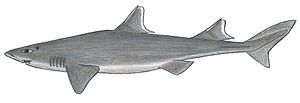Cirrhigaleus
| Cirrhigaleus | ||||||||||||
|---|---|---|---|---|---|---|---|---|---|---|---|---|

Rough-skin dogfish ( Cirrhigaleus asper ) |
||||||||||||
| Systematics | ||||||||||||
|
||||||||||||
| Scientific name | ||||||||||||
| Cirrhigaleus | ||||||||||||
| Tanaka , 1912 |
Cirrhigaleus is a genus within the dogfish (Squalidae), which consists of two or three species : the mandarin snout dogfish ( C. barbatus ) and the rough-skinned dogfish ( C. asper ) as recognized species as well as the southern mandarin snout dogfish described in 2007( C. australis ).
Appearance and characteristics
The species of the genus Cirrhigaleus are medium-sized sharks with a maximum body length of 120 centimeters. They gave a typical squat body with a broad, flat head. The two barbels that start at the nostrils and are particularly long in the Mandarin Schnauz dogfish and extend to the mouth are noticeable.
Their backs are gray-brown and their belly is white; their skin is very coarse compared to other sharks. The rear edges of all fins are white without any further drawing. Confusion of the two species can be avoided due to the significantly longer barbels of the mandarin snout dogfish and the different range of distribution.
They have no anal fin and two dorsal fins with the order-typical spines in front of the dorsal fins. The first dorsal fin begins behind the end of the pectoral fins and is slightly larger than the second dorsal fin. The pectoral fins are large and broadly triangular. Like all kinds of order, the animals have five gill slits and a spray hole behind the eye.
Way of life
Both species live near the coast above the continental shelf and occur at depths of 70 to over 600 meters. Both live mainly near the ground or directly on the seabed. The food spectrum of the mandarin snout dogfish is not yet known, the rough-skinned dogfish feed on small bony fish and molluscs such as squid. It is believed that barbels contain chemoreceptors used to track down prey. Both types are harmless to humans.
Like other species of the order, they are viviparous, with the mother giving birth to 10 to 22 juvenile sharks (only one litter of 10 juvenile sharks has been documented in the Mandarin Schnauz dogfish). The sharks reach sexual maturity with a length of 85 to 110 centimeters.
distribution
The ranges of the species include several separate areas in all oceans. The rough-skinned dogfish can be found in the western Indian Ocean , off the coast of Africa , in the central Pacific, in the Gulf of Mexico and off the southern Brazilian coast. The mandarin snout dogfish occurs south of Japan in the north Pacific and the newly described southern mandarin snout dogfish has a relatively large distribution area in the reef areas of New Zealand and off the east coast of Australia .
Systematics
The genus Cirrhigaleus currently consists of two or three species: the mandarin-snouted dogfish ( C. barbatus ) and the rough-skinned dogfish ( C. asper ) as recognized species, as well as the southern mandarin-snouted dogfish ( C. australis ), described in 2007 , which is found which includes populations off the coasts of Australia and New Zealand that were previously taken as mandarin schnauz dogfish and thus reduced the former to the North Pacific occurrences.
Danger
The rough-skinned dogfish is included in the IUCN Red List as "data deficient", so there is too little data available for a risk assessment. It is not fished commercially and is therefore only caught as by-catch . The Mandarin Schnauz spiny dogfish is classified in the IUCN Red List as a type of warning list ("near threatened") because it is seldom sighted in its range or caught as bycatch in fisheries.
supporting documents
- ↑ William T. White1, Peter R. Last, John D. Stevens: cirrhigaleus australis n sp, a new Mandarin dogfish (Squaliformes: Squalidae).. From the south-west Pacific Zootaxa 1560, 2007: 19-30.
- ↑ cirrhigaleus asper in the endangered Red List species the IUCN 2008. Posted by: Herndon, AP & Burgess, GH, 2006. Retrieved on 8 November, 2008.
- ↑ cirrhigaleus barbifer in the endangered Red List species the IUCN 2008. Posted by: White, WT (SSG Australia & Oceania Regional Workshop, March 2003), 2003. Retrieved on 8 November, 2008.
literature
- Leonard Compagno , Marc Dando, Sarah Fowler: Sharks of the World. Princeton Field Guides, Princeton University Press , Princeton and Oxford 2005; Pp. 71-73. ISBN 978-0-691-12072-0